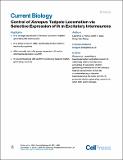Control of Xenopus tadpole locomotion via selective expression of Ih in excitatory interneurons
Abstract
Locomotion relies on the coordinated activity of rhythmic neurons in the hindbrain and spinal cord, and depends critically on the intrinsic properties of excitatory interneurons. Therefore, understanding how ion channels sculpt the properties of these interneurons, and the consequences for circuit function and behavior, is an important task. The hyperpolarization-activated cation current, Ih, is known to play important roles in shaping neuronal properties and for rhythm generation in many neuronal networks. We show in stage 42 Xenopus laevis frog tadpoles that Ih is strongly expressed only in excitatory descending interneurons (dINs), an important ipsilaterally projecting population that drives swimming activity. The voltage-dependent HCN channel blocker ZD7288 completely abolished a prominent depolarising sag potential in response to hyperpolarization, the hallmark of Ih, and hyperpolarized dINs. ZD7288 also affected dIN post-inhibitory rebound firing, upon which locomotor rhythm generation relies, and disrupted locomotor output. Block of Ih also unmasked an activity-dependent ultraslow afterhyperpolarization (usAHP) in dINs following swimming, mediated by a dynamic Na/K pump current. This usAHP, unmasked in dINs by ZD7288, resulted in suprathreshold stimuli failing to evoke swimming at short inter-swim intervals, indicating an important role for Ih in maintaining swim generation capacity and in setting the post-swim refractory period of the network. Collectively, our data suggest that the selective expression of Ih in dINs determines specific dIN properties that are important for rhythm generation and counteracts an activity- dependent usAHP to ensure that dINs can maintain coordinated swimming over a wide range of inter-swim intervals.
Citation
Picton , L D , Sillar , K T & Zhang , H-Y 2018 , ' Control of Xenopus tadpole locomotion via selective expression of Ih in excitatory interneurons ' , Current Biology , vol. 28 , no. 24 , pp. 3911-3923 . https://doi.org/10.1016/j.cub.2018.10.048
Publication
Current Biology
Status
Peer reviewed
ISSN
0960-9822Type
Journal article
Description
The authors are grateful for the support of the Biotechnology and Biological Science Research Council (BBSRC) [grant number BB/J01446X/1 and BB/M024946/1] and the Wellcome Trust-University of Edinburgh Institutional Strategic Support Fund (ISSF).Collections
Items in the St Andrews Research Repository are protected by copyright, with all rights reserved, unless otherwise indicated.

